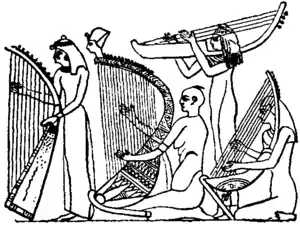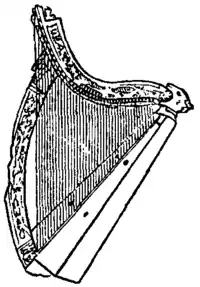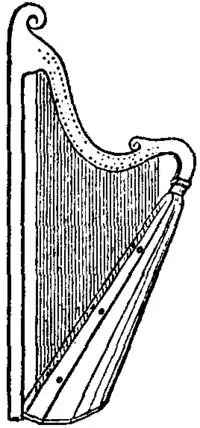HARP
13
from the simplest bow-form to the almost triangular harp, into one family (see fig. 2).
 |
| Fig. 2. |
The Egyptian harp had no front pillar, and as it was strung with catgut the tension and pitch must necessarily have been low. The harps above-mentioned depicted in the tomb at Thebes, assumed from the players to be more than 6 ft. high, have not many strings, the one having ten, the other thirteen. What the accordance of these strings was it would be hard to recover. We must be content with the knowledge that the old Egyptians possessed harps in principle like our own, the largest having pedestals upon which they bestowed a wealth of decoration, as if to show how much they prized them.
The ancient Assyrians had harps like those of Egypt in being without a front pillar, but differing from them in having the sound-body uppermost, in which we find the early use of soundholes; while the lower portion was a bar to which the strings were tied and by means of which the tuning was apparently effected.[1] What the Hebrew harp was, whether it followed the Egyptian or the Assyrian, we do not know. That King David played upon the harp as commonly depicted is rather a modern idea. Medieval artists frequently gave King David the psaltery, a horizontal stringed instrument from which has gradually developed the modern piano. The Hebrew “kinnor” may have been a kind of trigonon, a triangular stringed instrument between a small harp and a psaltery, sounded by a plectrum, or more probably, as advocated by Dr Stainer in his essay on the music of the Bible, a kind of lyre.
The earliest records that we possess of the Celtic race, whether Gaelic or Cymric, give the harp a prominent place and harpists peculiar veneration and distinction. The names for the harp are, however, quite different from the Teutonic. The Irish “clairseach,” the Highland Scottish “clarsach,” the Welsh, Cornish, Breton “telyn,” “telein,” “télen,” show no etymological kinship to the other European names. The first syllable in clairseach or clarsach is derived from the Gaelic “clar,” a board or table (soundboard), while the first syllable of telyn is distinctly Old Welsh, and has a tensile meaning; thus resonance supplies the one idea, tension the other.
 |
| Fig. 3. Irish (Dalway) Harp. |
 |
| Fig. 4. Welsh Triple Harp. |
The literature of these Celtic harps may be most directly found in
Bunting’s Ancient Music of Ireland (Dublin, 1840), Gunn’s Historical
Enquiry respecting the Performance on the Harp in the Highlands
of Scotland (Edinburgh, 1807), and E. Jones’s Musical and Poetical
Memoirs of the Welsh Bards (London, 1784). The treatises of Walker,
Dalyell, and others may also be consulted; but in all these authorities
due care must be taken of the bias of patriotism, and the delusive
aim to reconstruct much that we must be content to receive as only
vaguely indicated in records and old monuments. There is, however,
one early Irish monument about which there can be no mistake, the
harp upon a cross belonging to the ancient church of Ullard near
Kilkenny, the date of which cannot be later than 830; the sculpture
is rude, but the instrument is clearly shown by the drawing in
Bunting’s work to have no front pillar. This remarkable structural
likeness to the old harps of Egypt and Assyria may be accidental,
but permits the plausible hypothesis of Eastern descent. The oldest
specimen of the beautiful form by which the Irish harp is now
recognized, with gracefully curved front pillar and sweep of neck
(the latter known as the harmonic curve), is the famous harp in
Trinity College, Dublin, the possession of which has been attributed
to King Brian Boiroimhe. From this mythic ownership Dr Petrie
(see essay in Bunting) has delivered it; but he can only deduce the
age from the ornamentation and heraldry, which fix its date in the
14th century or a little later. There is a cast of it in the Victoria
and Albert Museum. The next oldest is in the Highlands of Scotland,
the Clarsach Lumanach, or Lamont’s Clarschoe, belonging, with
another of later date, to the old Perthshire family of Robertson of
Lude. Both are described in detail by Gunn. This Lamont harp
was taken by a lady of that family from Argyleshire about 1460,
on her marriage into the family of Lude. It had about thirty strings
tuned singly, but the scale was sometimes doubled in pairs of unisons
like lutes and other contemporary instruments. The Dalway harp
in Ireland (fig. 3) inscribed “Ego sum Regina Cithararum,” and
dated 1621, appears to have had pairs of strings in the centre only.
These were of brass wire, and played with the pointed finger-nails.
The Italian contemporary “Arpa Doppia” was entirely upon the
duplex principle, but with gut strings played by the fleshy ends of
the fingers. When E. Bunting met at Belfast in 1792 as
many Irish harpers as could be at that late date assembled, he
found the compass of their harps to comprise  thirty notes which were tuned diatonically in the key of G, under
certain circumstances transposable to C and rarely to D, the scales
being the major of these keys. The harp first appeared in the coat
of arms of Ireland in the reign of Henry VIII.; and some years
after in a map of 1567 preserved in a volume of state papers, we
find it truly drawn according to the outlines of the national Irish
instrument.[2] References to the Highlands of Scotland are of necessity
included with Ireland; and in both we find another name
erroneously applied by lexicographers to the
harp, viz. “cruit.” Bunting particularly
mentions the “cinnard cruit” (harp with
a high head) and the “crom cruit” (the
curved harp). In the Ossianic MSS. of the
Dean of Lismore (1512) the word “crwt”
occurs several times, and in Neill M’Alpine’s
Gaelic Dictionary (1832), which gives the
dialect of Islay, closely related to that of
Ulster, the word “cruit” is rendered
“harp.” The confusion doubtless arose from
the fact that from the 11th century cithara
is glossed hearpan in Anglo-Saxon MSS., a
word which, like citharisare in medieval
Latin, referred to plucking or twanging of
strings in contradistinction to those instruments
vibrated by means of the bow. In
Irish of the 8th and 9th centuries (Zeuss)
cithara is always glossed by “crot.” The modern Welsh “crwth”
is not a harp but a “rotta” (see Crowd). An old Welsh harp,
not triple strung, exists, which bears a great resemblance to
the Irish harp in neck, soundboard and soundholes. But this
does not imply derivation of the harp of Wales from that of
Ireland or the reverse. There is really no good historical evidence,
and there may have been a common or distinct origin on which
ethnology only can throw light.[3] The Welsh like the Irish harp
was often an hereditary instrument to be preserved with great
care and veneration, and used by the bards of the family, who were
alike the poet-musicians and historians. A slave was not allowed
to touch a harp, and it was exempted by the Welsh laws from seizure
for debt. The old Welsh harp appears to have been at one time
strung with horse-hair, and by the Eisteddfod laws the pupil spent
his noviciate of three years in the practice of a harp with that stringing.
The comparatively modern Welsh triple harp (fig. 4) is always
strung with gut. It has a rising neck as before
stated, and three rows of strings,—the outer rows
tuned diatonic, the centre one chromatic for the
sharps and flats. Jones gives it 98 strings and
a compass of 5 octaves and one note, from
violoncello C. As in all Celtic harps, the left is
the treble hand, and in the triple harps there are
27 strings on that side, the right or bass hand
having 37, and the middle or chromatic row 34.
thirty notes which were tuned diatonically in the key of G, under
certain circumstances transposable to C and rarely to D, the scales
being the major of these keys. The harp first appeared in the coat
of arms of Ireland in the reign of Henry VIII.; and some years
after in a map of 1567 preserved in a volume of state papers, we
find it truly drawn according to the outlines of the national Irish
instrument.[2] References to the Highlands of Scotland are of necessity
included with Ireland; and in both we find another name
erroneously applied by lexicographers to the
harp, viz. “cruit.” Bunting particularly
mentions the “cinnard cruit” (harp with
a high head) and the “crom cruit” (the
curved harp). In the Ossianic MSS. of the
Dean of Lismore (1512) the word “crwt”
occurs several times, and in Neill M’Alpine’s
Gaelic Dictionary (1832), which gives the
dialect of Islay, closely related to that of
Ulster, the word “cruit” is rendered
“harp.” The confusion doubtless arose from
the fact that from the 11th century cithara
is glossed hearpan in Anglo-Saxon MSS., a
word which, like citharisare in medieval
Latin, referred to plucking or twanging of
strings in contradistinction to those instruments
vibrated by means of the bow. In
Irish of the 8th and 9th centuries (Zeuss)
cithara is always glossed by “crot.” The modern Welsh “crwth”
is not a harp but a “rotta” (see Crowd). An old Welsh harp,
not triple strung, exists, which bears a great resemblance to
the Irish harp in neck, soundboard and soundholes. But this
does not imply derivation of the harp of Wales from that of
Ireland or the reverse. There is really no good historical evidence,
and there may have been a common or distinct origin on which
ethnology only can throw light.[3] The Welsh like the Irish harp
was often an hereditary instrument to be preserved with great
care and veneration, and used by the bards of the family, who were
alike the poet-musicians and historians. A slave was not allowed
to touch a harp, and it was exempted by the Welsh laws from seizure
for debt. The old Welsh harp appears to have been at one time
strung with horse-hair, and by the Eisteddfod laws the pupil spent
his noviciate of three years in the practice of a harp with that stringing.
The comparatively modern Welsh triple harp (fig. 4) is always
strung with gut. It has a rising neck as before
stated, and three rows of strings,—the outer rows
tuned diatonic, the centre one chromatic for the
sharps and flats. Jones gives it 98 strings and
a compass of 5 octaves and one note, from
violoncello C. As in all Celtic harps, the left is
the treble hand, and in the triple harps there are
27 strings on that side, the right or bass hand
having 37, and the middle or chromatic row 34.
The first pattern of the modern harp is discovered in German and Anglo-Saxon illuminated MSS. as far back as the 9th century.[4] A diatonic instrument, it must have been common throughout Europe, as Orcagna, Fra Angelico, and other famous Italian painters depict it over and over again in their masterpieces. No accidental semitones were possible with this instrument, unless the strings were shortened by the player’s fingers. This lasted until the 17th century, when a Tirolese maker adapted hooks[5] (perhaps suggested by the fretted or bonded clavichord) that, screwed into the neck, could be turned downwards to fix the desired semitone at pleasure. At last, somewhere about 1720, Hochbrucker, a Bavarian, invented pedals that, acting through the pedestal of the instrument, governed by mechanism the stopping, and thus left the player’s hands free, an indisputable advantage; and it became possible at once to play in no less
- ↑ Representations of these may be seen among the musical scenes in the Nimrod Gallery at the British Museum.
- ↑ See also a woodcut in John Derrick’s Image of Ireland (1581), pl. iii. (Edinburgh ed. 1883).
- ↑ See the fine volume Musical Instruments on the Irish and Scottish harps by Robert Bruce Armstrong (1904), vol. i. Vol. ii., which deals with the Welsh harp, has unfortunately been withdrawn from sale.
- ↑ See for the medieval harp a careful article by Hortense Panum, “Harfe und Lyra im alten Nord-Europa,” in Intern. Mus. Ges. vol. vii. pt. 1 (Leipzig, 1905); and for references as to illuminated MSS., early woodcuts, paintings, &c. see Hugo Leichtentritt, “Was lehren uns die Bildwerke des 14-17 Jahrhunderts über die Instrumentalmusik ihrer Zeit?” ibid. vol. vii. p. 3 (Leipzig, 1906).
- ↑ See Nauwerk, “Die Hakenharfe, Die Vervollkommnung des Mechanismus an der deutschen Harfe.” in Allg. musik. Ztg. (Leipzig, 1815), p. 545 seq.